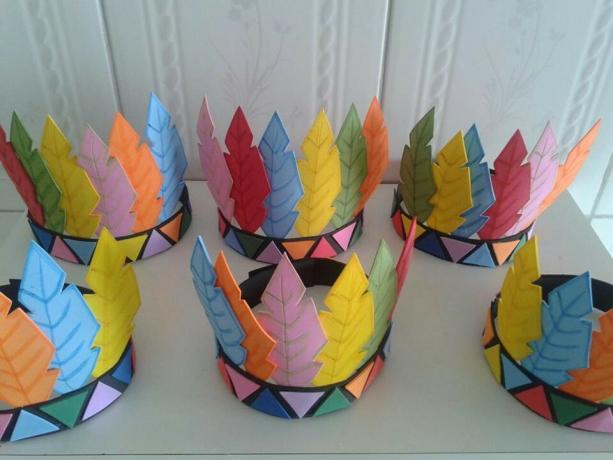O Indian's day is celebrated annually on the 19th of April and to work on this date we have selected some suggestions for Dynamics and Games for the Indian Day.
They are excellent resources that they provide through play, indigenous children learn several things: hunting, fishing, planting, making clay pots, weaving baskets and other things.
Index
CURUMIM GOES TO HERE!!!
Material:
Development:
JAGUAR HUNTING
Materials:
Development:
Be sure to talk to the children about what they thought of the games and what they learned.
Be sure to check: Several ideas for activities for the Indian Day

Assorted Indian Day Games
In the villages, children play with their pets: dog, macaw, monkey, coati and parrot. Lots of partying in the river baths and in the forest races. They learn a lot from the stories told by the older Indians about animals and plants, the origin of the world, as well as the history of their people and their customs.
Let's learn a little more about them with these Dynamics and Games for the Indian Day, check out:
Fun of the Tukano Indians – Alto Rio Negro, AM

The Tuxáua (chief) Sapo gathers his relatives in a line in his village to ask what each one wants to eat. Frogs can only respond to mosquitoes (carapanã). Those who mention other foods such as fruits (cuki, uacu and umari) gain poison from Tuxáua Sapo and die. Only those who find the true food of the frogs will survive: the insects. As a prize, the winners will be part of the boss's group.
A joke by the Canela Indians – Barra do Corda, MA

One child represents the hawk and the others form a line, starting with the tallest. Each child hugs the partner in front tightly, with both arms going under the partner's arms. The hawk, released, yells “Tip” (I'm hungry). The first in line shows his legs "Tu senan sini?" (do you want this?). The hawk says "It's pela" to all of them, except for the last one to the one who says "Iná!" (yea); and he runs off after her. The group, always hugging, tries to surround the bird. If the hawk catches the child, it takes it to its nest. The game continues until the animal grabs all the other older children in the order.
Propose students to paint holed noodles and make necklaces, bracelets, belts and anklets imitating indigenous art. To make a headdress, just glue colored feathers between the noodles.
Propose a survey regarding indigenous contributions: names, cuisine, arts, etc.
The Indians are very important in the formation of the Brazilian people. Many of our habits, the foods we eat and the words we use are of indigenous origin.
The class divided into 4 teams must answer questions, by drawing lots, on a subject already taught in class. For each correct answer, the team will receive material to make the necklace (pieces of string or nylon thread and assorted beads, which must be the color of each team – up to 8 beads per student).
Questions
Each team, wearing their necklaces, receives a list consisting of various objects, which they should look for in the room itself, in the courtyard and wherever else it is possible to hide, which was done in advance by the teacher. These objects will be, whenever possible, in the colors of each team, to prevent one not taking the objects of the other. All objects on the list will be in equal quantities to all teams except the amulet which will have only one. Browse the objects listed below. Always look for the color of your team: 10 bird feathers, 5 dry leaves, 1 flower, 3 ears of corn, 2 round stones, 1 biscuit amulet (little clay bug), 1 y-shaped stick, 3 seeds. The team that manages to gather all the requested objects wins, therefore, the one that manages to find all the requested objects including the amulet, which will have only one hidden.

The four teams will be seated on the floor in single file, side by side. About 5 meters ahead of each team, there will be a table with several strips of fabric and feathers dyed in the team colors, in quantities equivalent to the number of participants. The fabric strips and dyed feathers are all mixed up. Given a signal, the last one in each row runs to the place where the strips of fabric and the feathers are and separates 5 feathers of their color and glues them on a strip of fabric, imitating a headdress. Once ready, you should put the headdress on your head and go back to your line, but in the first place. Immediately, the last one should come out and do the same thing. The team that finishes first and all the components are wearing the headdress will be the winner. The winning team will receive a special penalty for their headdresses.
Some Indian tribes run a race carrying logs (pieces of tree trunks) to assess which people have the strongest warriors. The teams will also run this race, but in pairs. Each two participants will have one leg tied to the other so that they have only three legs. Pairs with tied legs should run a predetermined distance, but blowing on a chicken or duck feather. If the penalty drops, start again. Upon reaching the final point, a new pair begins the course, blowing another feather. The feather must always be in the air. Everyone on the team must participate, always in pairs and with their legs tied. The team that completes the task first wins. The winning team will get extra necklaces. After the game, all teams will have to get ready to participate in the party, for that they will receive makeup to decorate their faces as if they were Indians too.
Subscribe to our email list and receive interesting information and updates in your email inbox
Thanks for signing up.